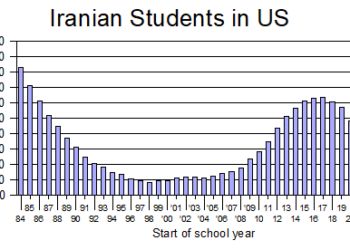February 28, 2020

The Islamic Republic tried to launch another satellite into orbit February 9, but, for the fourth time in a row, failed, as the satellite plunged to its death in the Indian Ocean.
The launch was broadcast live on state television, but the failure happened in space and was not seen by the viewing public.
Iran appears to be marching backward with its space program. After successfully putting four satellites into orbit, albeit briefly each time, it has now failed four times in a row.
Despite 11 years of effort, it is still unable to get a satellite into a circular orbit so it will stay in orbit for a prolonged time. Iran’s first satellite, Omid, launched February 3, 2009, remained in orbit a mere 80 days before plunging to its death because its orbit was so elliptical that it could not remain aloft.
And that is the country’s most successful satellite. Successive satellites have remained in orbit just 21 days, 60 days, 24 days and now zero days for the last four launches.
Iran has now devoted 11 years to its satellite program with effectively nothing to show for it. It only took the United States 11-1/2 years to go from putting its first satellite into orbit to landing men on the moon.
Iran does own one satellite in orbit. On October 27, 2005, Russia launched the Sina satellite that it had built for Iran. After more than 14 years, Sina is still circling the earth. But it is a Russian-built satellite launched from a Russian-built rocket.
The Islamic Republic did not characterize the launch of the latest Zafar satellite as a failure. In fact, news organizations uniformly and incongruously said the launch was a “success” even though they announced the satellite ended up on the ocean floor. Officials were quoted as saying the first and second stages of the launcher worked perfectly but the third stage did not achieve sufficient speed to put the satellite in orbit.
NASA said the rocket was about 1,000 meters per second short of the 7,400 needed to put the satellite in orbit.
A Defense Ministry spokesman said the failure was a “remarkable” achievement. And Telecommunications Minister Mohammad-Javad Azari-Jahromi tweeted, “But We’re UNSTOPPABLE! We have more Upcoming Great Iranian Satellites!”
The regime was clearly embarrassed and did not seem prepared for failure. The Islamic Republic News Agency (IRNA), the state-run news agency, reported at mid-day February 9 that the Zafar “will be launched within hours.” The next story ran 10 hours later and said, “Azari-Jahromi said late on Sunday that another copy of the Zafar satellite will be sent into orbit in June. He made the remarks after the Zafar satellite failed to get into orbit.” IRNA did not carry a story leading with the fact that the launch had failed.
The launcher was Iran’s second generation Simorgh rocket that was intended to put larger satellites into a higher altitude. Zafar weighed in at 113 kilos, or roughly double the size of Iran’s previous satellites carried aloft by the older Safir rocket, and Zafar was to go into an orbit 530 kilometers above the earth, also about double the altitude of the previous satellites.
But Simorgh has been fired to orbital altitude three times and has failed all three—on a test flight with no satellite in 2017 and with a satellite on board last year and this.
Although the government said the satellite crashed into the Indian Ocean, an official at the office of the governor general of Sistan va Baluchestan province said parts of satellite and rocket had crashed near Zahedan. The government has not clarified whether that was correct or in error.
Telecommunications Minister Azari-Jahromi has changed policy by announcing the last three launches in advance—rather than just announcing successes afterward. Unfortunately, all the launches he has announced in advance have now been failures.
Azari-Jahromi said Iran had built a second copy of the Zafar satellite as a backup and will now try to orbit it in June.
In addition, Iran’s published schedule contains plans to launch four other satellites in the coming Persian year. But Iran has never come close to meeting its published launch schedule.
Iran’s space launch base is located in the middle of the desert in Semnan province so there are no residents around to see what is going on, unlike at Cape Canaveral, Florida, from which US manned flights are launched and where the public can watch from nearby. The Financial Tribune said Iran’s launch pad is a 30-minute drive from the gate to the base.
The Trump Administration used the launch to complain that Iran’s satellite program was nothing but a cover for developing its military missiles.
Secretary of State Mike Pompeo said space launch technology is “virtually identical” to the technology needed to fire long-range ballistic missiles.
He said, “Each launch, whether failed to not, further allows Iran to gain experience using such technologies that could benefit its missile programs under the guise of a peaceful space program.”
Rocket scientists generally say there is an overlap between the technologies used in a space program and military missiles, but balk at Pompeo’s conclusion that they are “virtually identical.”
However, the main problem with Pompeo’s conclusion that Iran is hiding its military research under the space program is that Iran has an active and public military missile program that it does not try to hide.


















